Preventing accidents through the application and combination of our accumulated technology. What is “peripheral monitoring radar” that is essential to ensuring the safety of mobility?
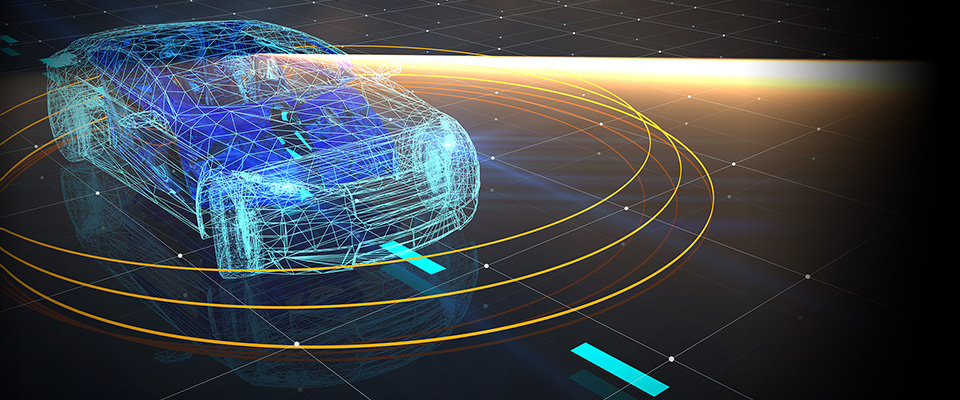
Over 100 years have passed since the start of mass production in the early 20th century of the automobiles that support our daily life, and during this time, speed, harmony with the environment, safety and comfort have all increased. As an extension of these advances, ADAS (Advanced Driver-Assistance Systems) is receiving attention from the 2 aspects of preventing traffic accidents and autonomous driving assistance. The peripheral monitoring radar developed by the Furukawa Electric Group supports ADAS as one of the sensors. This radar applies our accumulated broadcast and communications technology to detect obstructions around the vehicle. How were development and successive improvements conducted in order to realize the world class detection functions? Let’s take a look at the original technology possessed by the peripheral monitoring radar, as well as the challenges encountered during development and utilization.
Peripheral monitoring radar supports our safe and secure mobility lifestyles
Given the increased awareness of automobile safety in recent years, a global trend has emerged toward realizing a mobility society with “zero traffic accidents”. ADAS (Advanced Driver-Assistance Systems) is receiving more attention as the system to support this trend. ADAS is a collective term used for the systems that assist safe operation of the vehicle by the driver, such as automatic brakes and acceleration suppression systems.
The peripheral monitoring radar developed and manufactured by Furukawa AS, a member of the Furukawa Electric Group, is one type of ADAS. When driving and also when stopped, the radar detects obstructions in front and behind the vehicle, as well as objects approaching from blind spots, and it alerts the driver, thereby supporting safe lane changes and parking.
※MMR : Multi Mode Radar
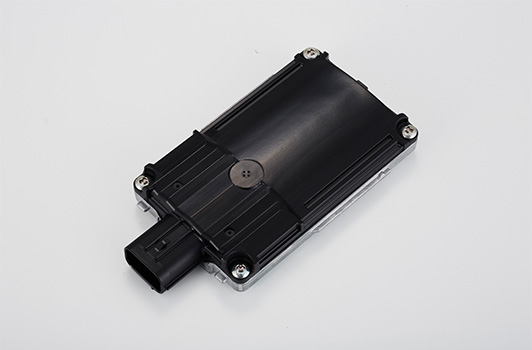
The ADAS sensors that sense the vehicle surroundings can use a wide range of inputs, including light, ultrasonic waves and infrared rays. Furukawa Electric’s radar uses quasi-millimeter waves, which enables stable performance even at night and during poor weather compared to other types of sensors. Also, along with the additional strength of being able to detect close proximity objects located within several meters from the vehicle, efforts are being made to improve detection of objects located as far away as 100 meters.
At intersections with poor visibility, there is the possibility of head-on collisions and other accidents, but peripheral monitoring radar contributes to preventing such accidents and supports our safe and secure mobility society.
Various detection functions of peripheral monitoring radar
Detect approaching obstructions when driving in reverse
Detect a vehicle approaching from behind when backing out of a parking spot.
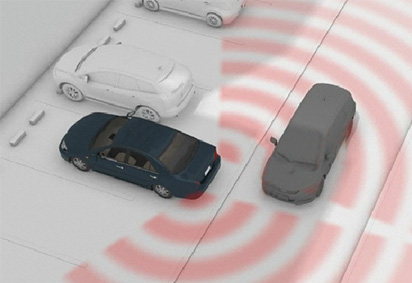
Blind spot detection
Detect other vehicles traveling alongside in a blind spot.
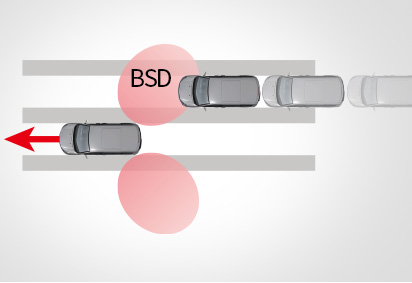
Lane change assistance
When changing lanes, detect vehicles approaching in the other lane at a faster speed.
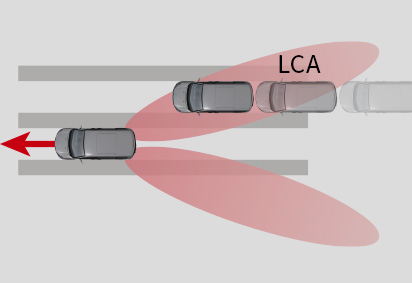
Detect approaching obstructions when driving forward
Detect pedestrians approaching from the side when turning onto the main road.
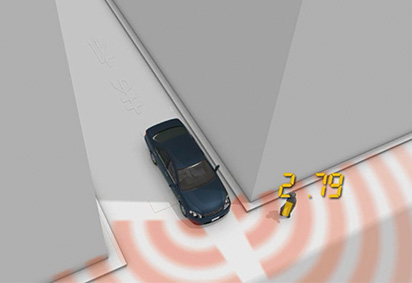
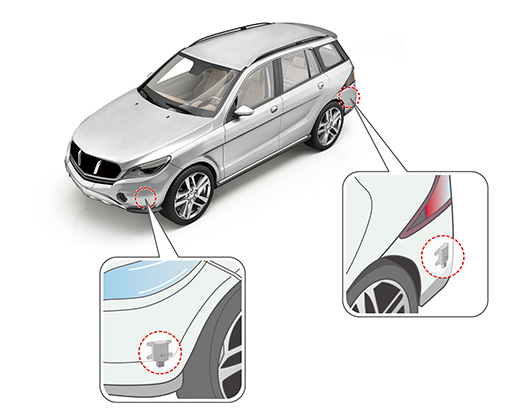
Ensuring forklift safety and as a roadway monitoring system
Peripheral monitoring radar is not only used in vehicles. It is also installed in forklifts used in factories, logistics warehouses and other workplaces. Forklifts are often used in spaces that are crowded with people, goods and other vehicles, as well as in workplaces where sensors tend to get covered up (with water or dirt), poorly lit workplaces and at night. As a result, there is a need to increase safety and resistance to the environmental conditions. The use of peripheral monitoring radar is growing as one means of responding to this need.

In addition, when the peripheral monitoring radar is installed in a fixed location, it is possible to monitor a single area. At Furukawa Electric, we utilize our peripheral monitoring radar’s broad detection area, high resistance to environmental conditions and stable detection performance even at night, in backlight situations and during poor weather for roadway traffic monitoring systems, including the detection of vehicle infractions that could lead to severe accidents.
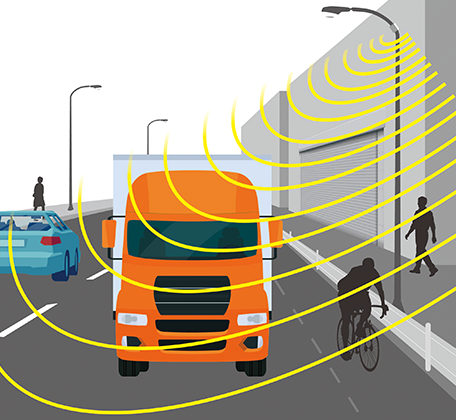
World-class performance is backed by the “broadcast and communications” technology accumulated over the years
The main feature of the MMR1 peripheral monitoring radar with world-class detection performance and stability developed by Furukawa AS in 2016 was the fact that it used the “quasi-millimeter wavelength (24GHz band) pulse method”.
Existing peripheral monitoring radar generally used the frequency-modulated continuous wave method by which electromagnetic waves are continuously broadcast and objects are detected based on differences in the frequency of the waves that are broadcast and received. However, there are a large number of reflective objects inside the bumper, leading to unstable measurements. This method had issues in relation to stable measurement performance, such as the signals from other objects being lost when a truck or other large object was located nearby.
On the other hand, peripheral monitoring radar using the pulse method, such as the radar developed by Furukawa AS, broadcasts electromagnetic waves “intermittently” and measures the “distance” to the object based on the time until the return signal is received and the “relative speed” of the object based on the frequency of the return signal. In this way, it is possible to separately measure the distance and speed and individually detect multiple objects, such as obstructions, people and signs. Also, because the 24GHz quasi-millimeter wave band features relatively low attenuation in situations such as rain and low transmission loss when passing through the bumper, it has excellent detection performance.
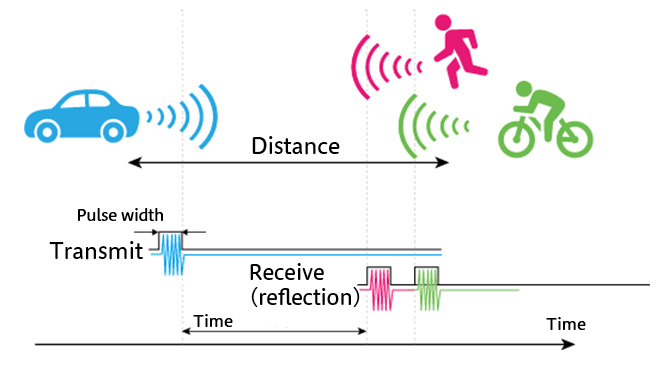
Behind our ability to successfully apply the high performance quasi-millimeter wave pulse method to peripheral monitor radar is our high frequency technology accumulated over the years, including the installation of a television broadcast antenna and power cable on the Tokyo Tower in 1958, which was the largest broadcast tower at the time.
Our pulse method radar also utilizes our signal transmission technology accumulated through optical communications in the telecommunications domain, a domain in which we have worked to remain at the forefront of research and development since the early days of the company. In this way, our peripheral monitoring radar was conceived through a combination of the Furukawa Electric Group’s accumulated broadcast and communications technology and in-vehicle digital control unit technology.
Increased performance, smaller size, lower weight. Challenging the solution of contradicting issues
In 2022, the 2nd generation MMR2 peripheral monitoring radar was developed and mass production started. Along with further improving the basic radar functions including detection range (distance and angle), detection speed and accuracy and fixed speed, the newly developed radar is also smaller and more lightweight. Behind these achievements are the extraordinary challenges undertaken by Furukawa AS.
Normally, in order to reduce the size of the radar unit, the surface area of the circuit boards is reduced, but the increased density of the components makes it necessary to take measures against noise and heat. Therefore, achieving increased performance along with smaller size and lighter weight has been a difficult issue for the entire industry.
In response, Furukawa AS solved this issue by revising the components and electronic circuit patterns and redesigning the configuration. This was not easy to accomplish, but while sharing various ideas and through repeated trial and error, it was ultimately possible to reduce the radar to the size of a business card.
Evolution of the peripheral monitoring radar developed by Furukawa AS

Also, “resistance against environmental conditions” is important in terms of peripheral monitoring radar to ensure the radar is not affected by the surrounding environment. Peripheral monitoring radar is often used in a wide range of environments, including the adherence of water and dirt and volatile changes in temperature and humidity.
Therefore, in order to ensure adaptability to harsh environmental conditions, Furukawa AS tested the peripheral monitoring radar in ambient temperatures ranging from 42℃ to -34℃. While making onsite improvements and repeatedly redesigning the radar, it was possible to realize the level of safety necessary for safeguarding human life even in workplaces such as construction sites, agriculture and transportation.
Using the radar functions for infrastructure systems that contribute to solving social issues
Peripheral monitoring radar is essential for protecting our lives and realizing a safe, secure mobility society. Going forward, along with installation during vehicle manufacturing, we want to make this radar available in the aftermarket, similar to car navigation systems.
Also, there have recently been efforts to use the features of this radar in completely different fields, including as a motion detector for detecting people while protecting privacy in locations such as nursing care facilities and as a sensor for preventing children from being left in parked vehicles.
Installing peripheral monitoring radar in even more vehicles will suppress and reduce traffic accidents, as well as contribute to SDGs and achieving carbon neutrality by increasing vehicle longevity and reducing CO2 emissions through less accident-related traffic and ambulance trips. We will continue to conduct research and development so that peripheral monitoring radar can be used in a wide range of settings and become an essential part of infrastructure systems that contribute to solving social issues.
 Share
Share Tweet
Tweet Share
Share